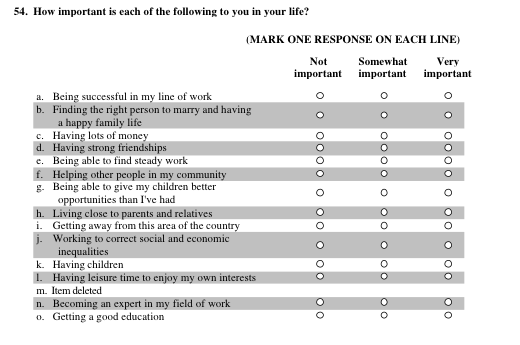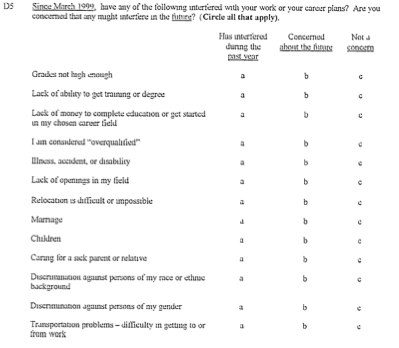Commissioned Papers and Items
ELS-2002-3rd-Follow-up-2012-Field-Test-Appendices 3 4 and 5 - Commissioned Papers and Items.doc
Education Longitudinal Study (ELS) 2002 Third Follow-up 2011 Field Test
Commissioned Papers and Items
OMB: 1850-0652
Appendix 3
Commissioned Paper: Randall J. Olsen
Suggestions for the Last ELS Follow-up
Randall J. Olsen
Department of Economics and
Center for
Human Resource Research
Ohio State University
As one thinks of instrumentation for the ELS 2002 survey, it helps to return to first principles and think about the overall purpose and potentially unique contribution of this study, which starts with sophomores in 2002 (and hence about 16 years old) and ends in 2012—the interview in question.
What is unique about the ELS and its kin is the detail on education, especially in terms of what is going on within a particular school and the student’s classroom, and on to cover post-secondary education. Having excellent detail on secondary education has the benefit of enabling a better understanding of post-secondary education. One of the axioms of education research is that no matter when you start studying the child, you will wish you had started earlier. Few studies have the patience and determination to start at birth or before and continue on through college. Those that do, such as the Children of the NLSY, do not have the wealth of data at the school level the ELS and its peer studies do. No one study can do it all.
What is important about the ELS and other studies mounted by NCES is that they can do a far more comprehensive job of focusing on the quality and attributes of education, whereas other studies are forced to content themselves with less demanding measures of the quantity of education even if in some cases these other studies generating better data on the quality of the child’s background and maternal characteristics.
If the issue of school quality is central to the contribution the ELS can make, one way of approaching the design problem is to ask which sorts of questions will provide the greatest resolution on outcomes central to the school quality domain? I will nominate some questions that may help with this in points below.
The area of survey content that is perhaps in the best shape is the way the ELS looks at post-secondary education in terms of applications, acceptances, and post-secondary educational outcomes. Those issues are terribly important and play to the strength of NCES. If we stipulate that NCES has this set of issues well in hand, we can turn to issues related to labor market outcomes and their linkage to school quality, attributes, and what the student learns in school.
One area of inquiry that a coalition of countries in the EU have been pursuing is to measure the extent to which post-secondary schooling (and training) is utilized by graduates. This is an idea that has great face validity. To be sure, utilization and/or usefulness can be rather inchoate descriptors, but allowing for a variety of descriptors is what one would do if such questions were asked. Given this will be the last interview, this would be the wave where more summary concepts should be pursued. After all, this interview will not be preparing the way for an event history to follow.
Here are some sample questions that may need revision, with the line of questioning being conditioned on the highest level of education or training received.
For college graduates and beyond:
Since graduating with your
(fill) degree in (fill field), have you ever worked in a job for
which your degree was a necessary qualification?
If yes: Are you still working in a job for which that degree is a qualification?
If yes: How satisfied are you with the training that degree provided you in terms of preparing you for your job? (5 point satisfaction scale)
If no: Thinking of that same degree, have you ever worked in a job for which your degree may not have been a necessary qualification, but provided skills that were clearly advantageous?
If yes: Are you still working in a job for which that degree was a clear advantage?
If yes: How satisfied are you with the training that degree provided you in terms of preparing you for your job? (5 point satisfaction scale)
If no to the questions on a degree being used:
Since graduation,
have you ever worked in a job for which your degree was a necessary
qualification?
If no: since graduation have you ever worked in a job for which your degree provided skills that were clearly advantageous?
You could also craft parallel questions that cover cases where the highest level of training revealed is vocational training, associate’s degree, apprentice training, adult workforce education, Adult Basic Literacy Education, and so forth.
Turning to the skills issue, if it is not already being done, combining the DOT-O*Net skill characteristics for jobs and cross-matching to area of study may be a fruitful way of generating data on the extent to which education and training match up with jobs held. In this regard, some thought should be given to what to ask about changes in jobs and/or occupations the respondent may have gone through. In the mid-20s, many young workers are starting to change occupations even as they change jobs.
For students who incurred debt for their schooling, the final interview could be used to elicit how that debt is being repaid. That is, ask the R what fraction of the debt has been forgiven by one program or another, what fraction has been paid off by them or their family, and what fraction remains to be paid off.
The NELS is hardly the place to collect balance sheet data, but there a couple of quick ways to determine how the R is doing financially. Most asset accumulation takes place in the form of housing so asking whether R owns or is buying their own home is a good starting point. Getting the value of the home and the size of the mortgage are, in most cases, feasible data collection objectives. Asking the respondent if they have started a retirement fund such as an IRA, 403b, 401k, etc. should likewise be feasible, including how much they have in all such accounts. In the 20’s, stopping there should be sufficiently informative. I would assign this topic a lower priority.
Asking how many full-time jobs the respondent has held since the previous interview will help put a lot of the economic data in context. After all, people change jobs either because they are fired or laid off, or to improve their situation. If we want to understand how effective education has been in improving economic circumstances, we want to measure job changing behavior as this is one of the key pathways through which earnings increase.
I suggest cutting the job satisfaction questions. The fact of job mobility and rates of pay tells us what we need to know. After all, people move to better opportunities. In this regard, the dropped job satisfaction questions could be replaced by questions about the first full-time job after high school (if current job is not the first, else first job after HS if not the current job). In particular, a high priority should go to collecting sufficient information to elicit the hourly rate of pay on that job (see next point). In that way, one can look at earnings growth, which is often very strong early in the career.
On earnings, the sequence in the ELS is suboptimal. I suggest using the protocol in the NLS. We start by asking the respondent:
[Now we would like to ask you a few questions concerning your earnings at (name of employer)] [(READ IF NECESSARY FOR TEACHERS): Please report your earnings (over the number of months that you were (contracted for/paid)./as you were paid over a (9/10) month period).]
For [(this job/current assignment or on-call job/business)] with [(employer name)]([QES-LOOP1 counter]), what is the easiest way for you to report your total earnings before taxes or other deductions: hourly, weekly, annually, or on some other basis?
(READ IF NECESSARY:) We use this information to compare the amount that people earn in different types of jobs.
2627 1 per hour
33 2 per day
425 3 per week
349 4 bi-weekly (every 2 weeks)
43 8 bi-monthly (twice a month)
227 5 per month
1977 6 per year
52 7 other (SPECIFY)
-------
5733
Even though you told me it is easier to report your earnings [time unit text for rate of pay]([QES-LOOP1 counter]), [are/were] you paid at an hourly rate on [(this job/current assignment or on-call job/business)] with [(employer name)]([QES-LOOP1 counter])?
1158 1 Yes (Go To T13750.00)
1846 0 No
-------
3004
(note: some intermediate checks and skips not shown)
This approach maximizes the frequency with which we receive an hourly rate of pay from the respondent, which attenuates measurement error problems that arise when the time unit of rate of pay is other than hourly and one must use reported hours to calculate the hourly rate of pay. This is important as hourly rate of pay is a workhorse variable of labor market analysis.
I would carefully consider removing the questions on smoking and health insurance. Seemingly everyone asks these questions, so the issue here is why the ELS data makes a contribution to understanding these issues as opposed to some other survey (actually, it is probably more accurate to say any other survey as the questions are ubiquitous). These questions are not harmful, but dropping them will create space to questions more tightly linked to the efficacy of the educational system and how education relates to career development. Elsewhere in this memo I give a list of questions for consideration, pretty much all of which would make more sense for inclusion than questions on smoking and health insurance.
In the event health-related questions are desired in the ELS, I would suggest a different set of questions. Specifically, I recommend including a 7-item CES‑D. According to the Partnership for Workplace Mental Health, mental illness causes more days of work loss and work impairment than chronic health conditions such as diabetes, asthma, arthritis, back pain, hypertension, and heart disease. Depression is likely the largest contributor to mental illness. To be sure, the estimate of the importance on mental health comes from an advocacy group, and may need verification and depression is a significant co-morbidity with other non-mental health conditions such as diabetes and heart disease. Nonetheless, depression is surely one of the more serious factors impairing workers. The CES‑D is often criticized for the relatively short reference period it uses for depressive symptomology, but in work currently underway, I use item response theory to analyze CES‑D results over a decade for several thousand women and find less than half the variance in the latent depressivity score is due to randomness specific to the respondent at the time of the interview. The rest of the variance is explained by either a time-invariant fixed effect or an autoregressive error component with a very high serial correlation.
The implication of this stability in underlying depressivity is that a single measure taken with the CES‑D has reasonable power to detect a serious and persisting health problem that affects education and efficiency in the workforce.
Education often fulfills two roles: providing additional skills to a person and also providing the skills needed to acquire additional skills. On the job training is an important way of acquiring skills and this can come either in the form of formal training programs or in the form of learning on the job. There is a series of questions in the 1993 NLSY79 that deal with on-the-job learning, including how long it took the respondent to feel comfortable at his/her job.
An alternative to these is to consider some of the questions appearing in the core Reflex instrument, which alluded to above in A and B, which has been widely administered as a paper and pencil self-interview across Europe and elsewhere. I have attached that instrument. Questions that could be included in a CATI interview (assuming they have not already been asked) are: A6, A7, A9, C3, C4, C5, D1–4, D7–13, E1–7, F1–15, G13–21.
The questions in H1 and H2 are quite different from what we see in the US. They are intriguing questions, but before putting them in the NELS, a pilot data collection effort might be the place to start. For example, making contact with 5–10 diverse universities interested in follow-up with their graduates might lead to such a pilot whose results could be analyzed to assess the utility of moving in this direction in the future. A collaborative effort with the NSF baccalaureate survey might be mutually beneficial as a way of assessing some of the more qualitative aspects of education.
If these questions are appealing and the Department of Education is interested is comparative analysis between the US and the rest of the world using these questions, I can provide a lead.
Appendix 4
Commissioned
Paper: Michael Shanahan
To: Steven J. Ingels
Re: Education Longitudinal Study, (Third Follow-up, 2012)
From: Michael J. Shanahan, [email protected]
Date: June 3, 2010
Purpose: The purpose of this memo is to discuss measures of adult transition markers and related measures for possible inclusion in the Third Follow-up of the Education Longitudinal Study (ELS).
TABLE OF CONTENTS
I. Traditional Demographic Markers 5
B. Family and Household Composition 6
II. Subjective Aspects of the Transition to Adulthood 15
A. Educational/Occupational Careers 15
B. Subjective Social Status 17
G. Timeliness of Transition Markers 24
III. Summary of Recommendations 25
A. Traditional Demographic Markers 25
Scope: Possibly relevant measures may be classified into four broad categories. First, the traditional demographic markers of adulthood (school completion, marriage, parenthood, start of first job for pay in career-line, establishment of one’s own household). Second, subjective aspects of these markers, including, for example, self-perceived adulthood, future plans, and perceived reasons for one’s pathway. Third, relatively newer concerns that elucidate the transition to adulthood: intergenerational assistance, experiences with the military, and finances beyond assets, for example. Fourth and finally, Steven asked me to consider missing gaps in previous surveys.
The document is organized into Traditional Markers and Subjective Assessments and the third and fourth categories of measures are integrated into these two sections.
Procedures: The average age of the sample at the Third Follow-up will be 26 years old and the time lag since the Second Follow-up will be about six years. I have reviewed previous instruments used by the ELS, NELS88:2002 (which assessed respondents with an average age of 26), the National Longitudinal Study of Adolescent Health (Add Health) Waves III and IV (covering 18-26 and 24-32 years old, respectively), and the Youth Development Study (YDS) Waves 12 (2000) and 13 (2002) (covering ages 26 and 27). (The Panel Study of Income Dynamics and the National Longitudinal Survey are much less relevant given the years of administration and the age of the respondents.) When possible I have included frequency distributions for recommended measures as they have been used already in national probability samples.
The durations between Waves II and III and between III and IV of Add Health are both roughly 6 years. NELS88:2000 also occurred approximately 6 years after the previous wave of data collection in 1994.
Given the focus, comparable lag, and recency of these studies, Add Health III and IV and NELS88:2000 are most relevant to the present circumstances. As will be seen, the Youth Development Study has used some subjective measures that may also be of interest.
I. Traditional Demographic Markers
A life-history calendar approach represents a straightforward and highly valuable method to collect these data, providing a month-by-month account of one’s roles with respect to school, work, and family living arrangements. The resulting data are quite rich and allow for different longitudinal modeling possibilities. However, this approach may not be feasible in the present case given the substantial time that has elapsed (6 years) since the last wave of data collection in 2006. (By comparison, the Youth Development, which uses the life-history calendar method, typically had one or two years between data collection points). It is unlikely that respondents could reliably and validly recall and record their work, family, and school involvements across 72 consecutive months.
1. Add Health. Waves III (Q. Section 7) and IV (Q. Section 9) focus on educational histories—highest level attained, degrees and certificates, and the dates of these degrees and certificates.
Wave III includes detailed histories of vocational training and/or job training programs: type of institution, field of study, date of any degrees. Few people reported attending more than two such programs since the last wave.
Wave IV includes an item about help from relatives and also an item tapping the respondent’s subjective assessment of educational attainment.
2. NELS88:2000. NELS draws on responses from the previous wave (1994) to then inquire about on-the-job training, several items about GEDS, specific names and dates of all schools attended, degrees and certificates received, majors or programs of study, cumulative GPA, primary reason for enrolling, reasons for leaving, future educational plans, expected degrees or certificates, recent continuing education. Pp. 15-60.
Recommendation: (R1) NELS is a superior protocol because it provides greater detail with respect to institutions attended, coursework, and performance. (R2) There is now considerable interest in familial support, so the item (H4ED7) from Wave IV of Add Health would be a potentially valuable addition. The item appears immediately below with observed frequencies. (The subjective item is discussed in section II below).

Given the time that will have elapsed between the Second and Third Follow-Up, it may be desirable to change the question to assess the % contribution to educational expenses after high school that were received from parents or any other relatives, including in-laws and step-parents.
B. Family and Household Composition
1. Add Health. Wave III (Section 2) collects household roster and number of geographic moves; marital history and values (Section 14); completed and current pregnancies and live births (Sections 22-24). Wave IV collects marital histories, pregnancies, live births (Sections 16, 17, and 19). For current parents, there are 4 subjective assessments of the parent role (tapping happiness, with parenthood closeness to children, children as major source of stress, overwhelmed by parenthood). Both waves inquire about group quarters (current) and homelessness (ever, current).
2. NELS88:2000. NELS collects marital histories and dates, children and dates (apparently first and last only), current household composition and dependents. Pp. 60-63. There is one item on housing status (living quarters) (p. 66-67).
Recommendation: (R3) The NELS protocol to update marital history and household composition and dependents is adequate. (R4) It would be useful to determine the birth dates of all children. (R5) It would be useful to determine residential histories—where R has lived and when (see H4HR10, 11MA, and 11YA from Add Health Wave IV below) given interest in geographic mobility. (R6) It would be useful to know the type of residence occupied (see H4HR1 and 2 from Add Health Wave IV below). (R7) Collection of addresses would allow the linking of participant to their local neighborhood (a geographic area), typically a census defined area such as a census blockgroup or census tract as well as for Zone Improvement Plan code areas (better known as ZIP codes). By way of geocoding, R could then be linked to a great deal of information (including an enhanced view of R’s socioeconomic status) about the neighborhood from the Decennial Census and the American Community Survey.


table continues with additional years…
these two questions are repeated until all moves accounted for

1. Add Health. Wave III (Section 8) collects start-stop dates and pay of first job, number of jobs held until current job, current job start-stop dates, wages etc., job classification, satisfaction, and military: branches, rank, start-stop dates.
Wave III (Section 15) covers finances: sources of personal income, earnings, total gross personal income, total gross household income, ownership of major assets, financial instruments, household negative financial events, extensive battery on public assistance.
Wave IV collections information about military service (Section 10): rank, branch, start-stop date, and combat experiences; this section also requests permission to access military records. Section 11 collects information about the labor market: information about first job, number of jobs to the present, current job: start-stop dates, job classification, benefits and hours, satisfaction, routinization, control(autonomy), work-family connections. Section 12 covers finances: total household and personal gross income, equity in home, total value of all assets excluding home equity, total debt excluding mortgage, total estimated household debt, negative financial events, government assistance, subjective social status.
2. NELS88: 2000 (pp. 1-16) collects current jobs, if unemployed last job and whether looking for work, with respect to current primary job: title, duties, employer, business, duties, occupation and industrial codes, how found, earnings, hours worked, satisfaction, control (or autonomy), numeracy, literacy, computers; planned job at age 30.
With respect to finances (pp. 63-66): personal annual gross income, Personal earnings, spousal earnings, personal and spousal other sources of income, personal gross annual earnings in previous 2 years and annual incomes, public assistance status and type received, health insurance and retirement program.
3. Youth Development Study. Month-by-month employment history, work values (importance of work attributes), sources of influences on career, sources of interference with career in past and future, payrate. For primary current job: how found, weekly work schedule, on-job training, control (autonomy), supervisory status, people/data/things, work stress, role overload, work involvement, coping strategies at work, relationships at work.
With respect to finances: sources that covered one’s expenses; perceived financial difficulties; annual income, health insurance and retirement program.
4. Recommendations. (R8) The NELS protocol pp.1-16 and 63-66 effectively covers much essential information about jobs and finances. (R9) Data should be collected on military service—branch, rank, start-stop dates, and exposures to combat. See Section 10 of Add Health Wave IV, in Appendix A (p. 25 et seq.). (R10) An assessment of personal and household debt would supplement the NELS protocol with its emphasis on income to allow for a calculation of wealth. See possible items from Add Health, appear immediately below: H4EC5, 8, and 9. (R11) An assessment of negative financial household events and perceived financial stress supplements this relatively objective information, which is advisable since these few items cannot capture the full complexity of a household economy. See possible items from Add Health immediately below. H4EC10-15. (R12). A single item assessing financial gifts would inform studies of intergenerational transfers, which of current interest. See item below, H4EC6.







II. Subjective Aspects of the Transition to Adulthood
Interest in subjective aspects of the transition to adulthood has grown considerably in the past decade. Many of these measures have not been used in national probability samples and it unclear how many of them are related to “objective” indicators of consequential behaviors and health.
However, the measures of the transition markers in NELS88:2000 could be supplemented with subjective assessments of adult transition markers that have been used in prior studies and that are the subject of scholarly interest. I would recommend the following for consideration:
A. Educational/Occupational Careers
(R13) Subjective Assessment of Educational Attainment & Occupational Career (Add Health)



Continues, next page
(R14) Subjective Social Status, as implemented recently by Add Health, Wave IV H4EC19. This measure is perhaps the most well-established of the measures discussed in this section and has been used extensively to study health.


(R15) Values—use Item 54 from the ELS Student Base Year Questionnaire (see below). This scale is commonly used (e.g., Youth Development Study; a subset appear in NELS88:94) and there are major modeling advantages to having the same items repeated across two measurement occasions.

(R16). Perceived sources of obstacles in educational and occupational careers. The second follow-up of ELS (Question Stems of Instruments, p. 7) included items assessing perceived obstacles that interfered with attaining one’s educational goals. These items could be repeated for Rs who have continued their educations since the last follow-up. Additionally, similar items could be included for occupational career. The following scale appeared in the Youth Development Study and includes reference to the past and anticipated future.

(R17). Future Circumstances. Several items will likely tap educational and career goals (see R13). The following items appear in Add Health Wave III.



(R18) Perceived adulthood. There is a great deal of interest in “emerging adulthood,” but there is no accepted measure and no measure that has demonstrated validity and reliability. (The major limitation appears to be that emerging adulthood is, at its core, defined in terms of role experimentation and lack of commitment, which are difficult to measure.) Item I5 immediately below, from the Youth Development Study, taps feeling like an adult.

G. Timeliness of Transition Markers
(R19) Timeliness of Transition Markers. The Youth Development also used a novel measure of perceived timing of transitions, I6 immediately below.

III. Summary of Recommendations
A. Traditional Demographic Markers
(R1) NELS88:2000 (pp. 15-60) is a superior protocol to assess educational careers because it provides greater detail with respect to institutions attended, coursework, and performance.
(R2) There is now considerable interest in familial support for educational expenses, so the item (H4ED7) from Wave IV of Add Health (Section 9) would be a potentially valuable addition.
(R3) The NELS protocol to update marital history and household composition and dependents is adequate.
(R4) It would be useful to determine the birth dates of all children.
(R5) It would be useful to determine residential histories—where R has lived and when (see H4HR10, 11MA, and 11YA from Add Health Wave IV) given interest in geographic mobility.
(R6) It would be useful to know the type of residence occupied (see H4HR1 and 2 from Add Health Wave IV below).
(R7) Collection of addresses would allow the linking of participant to their local neighborhood (a geographic area), typically a census defined area such as a census blockgroup or census tract as well as for Zone Improvement Plan code areas (better known as ZIP codes). By way of geocoding, R could then be linked to a great deal of information (including an enhanced view of R’s socioeconomic status) about the neighborhood from the 2010 Decennial Census and the American Community Survey.
(R8) The NELS protocol pp.1-16 and 63-66 effectively covers much essential information about jobs and finances.
(R9) Data should be collected on military service—branch, rank, start-stop dates, and exposures to combat. See Section 10 of Add Health Wave IV, in Appendix A.
(R10) An assessment of personal and household debt would supplement the NELS protocol with its emphasis on income to allow for a calculation of wealth. See possible items from Add Health, appear immediately below: H4EC5, 8, and 9.
(R11) An assessment of negative financial household events and perceived financial stress supplements this relatively objective information, which is advisable since these few items cannot capture the full complexity of a household economy. See possible items from Add Health immediately below. H4EC10-15.
(R12) A single item assessing financial gifts would inform studies of intergenerational transfers, which of current interest. See item H4EC6.
B. Subjective Assessments for Possible Inclusion
(R13) Subjective Assessment of Educational Attainment & Occupational Career (Add Health)
(R14) Subjective Social Status, as implemented recently by Add Health, Wave IV H4EC19.
(R15) Values—use Item 54 from the ELS Student Base Year Questionnaire (see below).
(R16). Perceived sources of obstacles in educational and occupational careers. The second follow-up of ELS (Question Stems of Instruments, p. 7) included items assessing perceived obstacles that interfered with attaining one’s educational goals. These items could be repeated for Rs who have continued their educations since the last follow-up. Additionally, similar items could be included for occupational career (see D5, Youth Development Study, above).
(R17). Future Circumstances. Several items will likely tap educational and career goals (see R13). Additionally, Add Health III included items gauging the subjectively assessed probability of future circumstances, H3EC56-61 (above).
(R18) Perceived adulthood, see Youth Development Study section I5 (above).
(R19) Timeliness of Transition Markers, see Youth Development Study section I6 (above).
Appendix A. Military Service Measures from Add Health
Wave IV Section 10: Military
Number of observations: 15,701
The next questions are about military service.
H4MI1
Num 1. Have you ever been in the
military?
Frequency Percent Value Label
14589 92.9% 0 no
1112 7.1% 1 yes
If Q.1 = 1, ask Q.2, else skip to Section 11.
H4MI2
Num 2. Was your military service in the US, outside the US, or
both?
Frequency Percent Value Label
511 3.3% 1 service in
the US
23 0.1% 2 service outside the
US
578 3.7% 3 both
14589 92.9% 7 legitimate skip
H4MI3 Num 3. Are you currently serving in the
military?
Frequency Percent Value Label
761 4.8% 0 no
351 2.2% 1 yes
14589 92.9% 7 legitimate
skip
If Q.1 = 1 or Q.3 = 1, ask Q.4, else go to Section 11.
4.
In which branches of the military have you served? You may select
more than one answer.
H4MI4A Num 4A.
Army
Frequency Percent Value Label
2
603 3.8% 0 not
selected
508 3.2% 1 selected
14589 92.9% 7 legitimate
skip
1 0.0% 8 don’t know
H4MI4B Num 4B. Air
Force
Frequency Percent Value Label
936 6.0% 0 not
selected
175 1.1% 1 selected
14589 92.9% 7 legitimate
skip
1 0.0% 8 don’t know
H4MI4C Num 4C. Marine
Corps
Frequency Percent Value Label
932 5.9% 0 not
selected
179 1.1% 1 selected
14589 92.9% 7 legitimate
skip
1 0.0% 8 don’t know
H4MI4D Num 4D.
Navy
Frequency Percent Value Label
862 5.5% 0 not
selected
249 1.6% 1 selected
14589 92.9% 7 legitimate
skip
1 0.0% 8 don’t know
H4MI4E Num 4E. Coast
Guard
Frequency Percent Value Label
1091 6.9% 0 not
selected
3
20 0.1% 1 selected
14589 92.9% 7 legitimate
skip
1 0.0% 8 don’t know
If C_TOTMIL > 1 and Q.3 = 1, ask Q.5, else skip to
Q.6.*
H4MI5 Num 5. In which branch are you
currently
serving?
Frequency Percent Value Label
11 0.1% 1 Army
3 0.0% 2 Air
Force
2 0.0% 4 Navy
15685 99.9% 7 legitimate skip
6. In which components of the military have you served? You may
select more than one answer.
H4MI6A Num 6A. Active
duty
Frequency Percent Value Label
175 1.1% 0 not
selected
935 6.0% 1 selected
14589 92.9% 7 legitimate
skip
2 0.0% 8 don’t know
H4MI6B Num 6B.
Reserves
Frequency Percent Value Label
899 5.7% 0 not
selected
211 1.3% 1 selected
14589 92.9% 7 legitimate
skip
2 0.0% 8 don’t know
H4MI6C Num 6C. National
Guard
4
Frequency Percent Value Label
961 6.1% 0 not
selected
149 0.9% 1 selected
14589 92.9% 7 legitimate
skip
2 0.0% 8 don’t know
If C_TOTCOM > 1 and Q.3 = 1, ask Q.7, else skip to
Q.8.*
H4MI7 Num 7. In which component are you
currently serving?
Frequency Percent Value Label
27 0.2% 1 active
duty
36 0.2% 2 reserves
23 0.1% 3 National
Guard
15615 99.5% 7 legitimate skip
H4MI8M Num 8M. In what month and year did your first military
service
begin?
[Month]
Frequency Percent Value Label
87 0.6% 1 January
79 0.5% 2 February
52 0.3% 3 March
55 0.4% 4 April
91 0.6% 5 May
145 0.9% 6 June
122 0.8% 7 July
127 0.8% 8 August
119 0.8% 9 September
97 0.6% 10 October
73 0.5% 11 November
5
52 0.3% 12 December
2 0.0% 96 refused
14589 92.9% 97 legitimate
skip
11 0.1% 98 don’t know
H4MI8Y Num 8Y. In what month and year did your first military
service
begin?
[Year]*
Frequency Percent Value Label
1 0.0% 1993 1993
13 0.1% 1994 1994
85 0.5% 1995 1995
150 1.0% 1996 1996
170 1.1% 1997 1997
144 0.9% 1998 1998
146 0.9% 1999 1999
137 0.9% 2000 2000
82 0.5% 2001 2001
60 0.4% 2002 2002
43 0.3% 2003 2003
34 0.2% 2004 2004
19 0.1% 2005 2005
13 0.1% 2006 2006
6 0.0% 2007 2007
5 0.0% 2008 2008
2 0.0% 9996 refused
14589 92.9% 9997 legitimate
skip
2 0.0% 9998 don’t know
6
If respondent is currently serving (Q.3 = 1), skip to
Q.10.
H4MI9M Num 9M. In what month and year did
your most recent military service
end?
[Month]
Frequency Percent Value Label
59 0.4% 1 January
60 0.4% 2 February
60 0.4% 3 March
52 0.3% 4 April
48 0.3% 5 May
74 0.5% 6 June
70 0.4% 7 July
74 0.5% 8 August
80 0.5% 9 September
68 0.4% 10 October
46 0.3% 11 November
53 0.3% 12 December
2 0.0% 96 refused
14940 95.2% 97 legitimate
skip
15 0.1% 98 don’t know
H4MI9Y Num 9Y. In what month and year did your most recent
military service
end?
[Year]*
Frequency Percent Value Label
1 0.0% 1994 1994
3 0.0% 1995 1995
14 0.1% 1996 1996
23 0.1% 1997 1997
36 0.2% 1998 1998
7
70 0.4% 1999 1999
68 0.4% 2000 2000
89 0.6% 2001 2001
70 0.4% 2002 2002
80 0.5% 2003 2003
74 0.5% 2004 2004
80 0.5% 2005 2005
66 0.4% 2006 2006
65 0.4% 2007 2007
17 0.1% 2008 2008
2 0.0% 9996 refused
14940 95.2% 9997 legitimate
skip
3 0.0% 9998 don’t know
H4MI10 Num 10. What is the highest military rank you have
achieved?
Frequency Percent Value Label
61 0.4% 1 E-1
49 0.3% 2 E-2
139 0.9% 3 E-3
360 2.3% 4 E-4
293 1.9% 5 E-5
115 0.7% 6 E-6
11 0.1% 7 E-7
2 0.0% 8 E-8
13 0.1% 11 O-1
3 0.0% 12 O-1E
10 0.1% 13 O-2
8
1 0.0% 14 O-2E
38 0.2% 15 O-3
4 0.0% 16 O-3E
2 0.0% 24 W-1
1 0.0% 25 W-2
1 0.0% 96 refused
14589 92.9% 97 legitimate
skip
9 0.1% 98 don’t know
If active duty is selected in Q.6, ask Q.11, else skip to next
section.
H4MI11Y Num 11Y. What is the total
amount of time you (have) served on active
duty?
[Years]*
Frequency Percent Value Label
97 0.6% 0 0 years
68 0.4% 1 1 year
90 0.6% 2 2 years
119 0.8% 3 3 years
210 1.3% 4 4 years
55 0.4% 5 5 years
80 0.5% 6 6 years
47 0.3% 7 7 years
57 0.4% 8 8 years
30 0.2% 9 9 years
43 0.3% 10 10 years
18 0.1% 11 11 years
17 0.1% 12 12 years
4 0.0% 13 13 years
14766 94.0% 97 legitimate
skip
9
H4MI11M Num 11M. What is the total amount of time you (have)
served on active
duty?
[Months]*
Frequency Percent Value Label
413 2.6% 0 0 months
39 0.2% 1 1 month
54 0.3% 2 2 months
44 0.3% 3 3 months
51 0.3% 4 4 months
29 0.2% 5 5 months
128 0.8% 6 6 months
29 0.2% 7 7 months
30 0.2% 8 8 months
44 0.3% 9 9 months
42 0.3% 10 10 months
32 0.2% 11 11 months
14766 94.0% 97 legitimate
skip
H4MI12Y Num 12Y. What is the total amount of time you (have)
served in a combat
zone?
[Years]*
Frequency Percent Value Label
676 4.3% 0 0 years
171 1.1% 1 1 year
53 0.3% 2 2 years
24 0.2% 3 3 years
4 0.0% 4 4 years
3 0.0% 6 6 years
1 0.0% 7 7 years
1 0.0% 8 8 years
10
1 0.0% 12 12 years
1 0.0% 15 15 years
14766 94.0% 97 legitimate
skip
H4MI12M Num 12M. What is the total amount of time you (have)
served in a combat
zone?
[Months]*
Frequency Percent Value Label
621 4.0% 0 0 months
29 0.2% 1 1 month
23 0.1% 2 2 months
37 0.2% 3 3 months
29 0.2% 4 4 months
11 0.1% 5 5 months
101 0.6% 6 6 months
20 0.1% 7 7 months
27 0.2% 8 8 months
15 0.1% 9 9 months
14 0.1% 10 10 months
8 0.1% 11 11 months
14766 94.0% 97 legitimate
skip
If C_TOTTIM = 0, skip to Q.17.*
The next set of
questions refers to your combat deployment. If you were deployed to a
combat
zone more than once, think about all your combat
deployments as you answer these questions.
H4MI13 Num
13. During your combat deployment, how many times did you engage
the
enemy in a firefight?
NOTE: Smallest 5 and largest 5 values are
displayed.
Frequency Percent Value Label
235 1.5% 0 0
times
32 0.2% 1 1 time
11
27 0.2% 2 2
times
12 0.1% 3 3 times
11 0.1% 4 4
times
108 0.7% 5-500 NOTE: Range of values omitted from
display
1 0.0% 666 666 times
4 0.0% 995 not asked on
pretest
4 0.0% 996 refused
15262 97.2% 997 legitimate
skip
5 0.0% 998 don’t know
H4MI14 Num 14. During your combat deployment, did you ever
kill or think you
killed
someone?
Frequency Percent Value Label
272 1.7% 0 no
154 1.0% 1 yes
7 0.0% 6 refused
15262 97.2% 7 legitimate
skip
6 0.0% 8 don’t know
H4MI15 Num 15. During your combat deployment, were you wounded
or
injured?
Frequency Percent Value Label
385 2.5% 0 no
52 0.3% 1 yes
1 0.0% 6 refused
15262 97.2% 7 legitimate
skip
1 0.0% 8 don’t know
16. During your combat deployment, did you see anyone wounded,
killed, or dead? Select all that apply.
H4MI16A Num 16A.
Yes, coalition or
ally
12
Frequency Percent Value Label
215 1.4% 0 not
selected
220 1.4% 1 selected
3 0.0% 6 refused
15262 97.2% 7 legitimate
skip
1 0.0% 8 don’t know
H4MI16B Num 16B. Yes,
enemy
Frequency Percent Value Label
277 1.8% 0 not
selected
158 1.0% 1 selected
3 0.0% 6 refused
15262 97.2% 7 legitimate
skip
1 0.0% 8 don’t know
H4MI16C Num 16C. Yes,
civilian
Frequency Percent Value Label
310 2.0% 0 not
selected
125 0.8% 1 selected
3 0.0% 6 refused
15262 97.2% 7 legitimate
skip
1 0.0% 8 don’t know
H4MI16D Num 16D.
No
Frequency Percent Value Label
284 1.8% 0 not
selected
151 1.0% 1 selected
3 0.0% 6 refused
13
15262 97.2% 7 legitimate
skip
1 0.0% 8 don’t know
We would like to obtain information from your military service record, including information on your military education, dates and geographic locations of service, and participation in military battles and engagements. This information will help us learn more about pathways into the military and the effects of military service on family formation and health. We will not request your medical records. In order to obtain your service record we will need your Social Security number. Would you provide your Social Security number so we can request your military service record? (Your Social Security number will be treated as confidential and used only for the purpose of obtaining your military service record.)
H4MI17 Num 17. Would you provide your social security
number?
Frequency Percent Value Label
426 2.7% 0 no
667 4.2% 1 yes
15 0.1% 5 not
asked on pretest
4 0.0% 6 refused
14589 92.9% 7 legitimate
skip
*H4MI8Y
Includes soft check if year < 1994: “Please
confirm the year in which most recent military service began.”
*H4MI9Y
Includes soft check if year < 1994: “Please
confirm the year in which most recent military service ended.”
*H4MI11Y, H4MI11M
Includes soft check if years > 18 or
if years + months total to > 18: “Please confirm the total
amount of time served on active duty.”
*H4MI12Y, H4MI12M
Includes soft check if years > 18 or
if C_TOTTIM > 216: “Please confirm the total amount of time
served in a combat zone.”
*C_ACTIDUTY, C_TOTMIL, C_TOTCOM, C_TOTTIM
Several
variables used in the skip instructions of this and other sections
were created as follows.
Variable
C_ACTIDUTY
Value is 1 if respondent is currently
on active duty military service: H4MI3=yes and
((H4MI6A=Active
Duty ONLY and H4MI7=blank) or (H4MI7=Active Duty))
C_TOTMIL
Sum of counts of: H4MI4A, H4MI4B, H4MI4C, H4MI4D, H4MI4E
C_TOTCOM
Sum of counts of: H4MI6A, H4MI6B, H4MI6C
C_TOTTIM Number of
months + number of years (converted to months) in a combat
zone:
H4MI12M + H4MI12Y
Appendix 5
Commissioned
Items—Robert Lent
Educational Domain Variables (5) and Items (17)
Educational Self-efficacy
I’m confident that I can earn strong grades in my educational program
I’m certain that I can understand the most difficult material presented in my courses
I’m confident that I can do an excellent job on my educational assignments
I’m confident that I could complete my degree despite financial pressures
I’m confident that I could complete my degree despite having competing demands for my time (e.g., from work or family)
Educational Outcome Expectations
Completing my educational program will help me to …
get a good job
get respect from people close to me (e.g., friends, family members)
earn enough money for the lifestyle I want to have
Educational Interests
I really like my educational program on the whole
I am enjoying the courses in my field of study
I get totally absorbed in what I am studying
Educational supports
I feel support from important people in my life for completing my educational program
My family members support my choice of educational program
I have access to a good mentor or advisor who can offer me advice and encouragement
Educational Persistence Intentions
I am totally convinced that I will complete my educational program
I think that earning a degree or certificate in my field of study is a realistic goal for me
I am fully committed to completing my educational program
Occupational Domain Variables (6) and Items (21)
Occupational Self-Efficacy (some items adapted from Dunn & O’Brien’s, 2009, Self-Efficacy in Work Domains scale)
I’m confident that I can perform my job at a very high level of skill
I’m certain that I can solve big problems that occur at work
I’m confident that I can reach the goals I set for myself at work
I’m certain that I can do my work well despite time pressures
I’m confident that I can do my work well even when I need to juggle work with non-work responsibilities (e.g., in my family or community)
Occupational Outcome Expectations
Remaining at my current job will allow me to …
get respect from other people
do work that I find satisfying
earn enough money for the lifestyle I want to have
work with other people who share my interests and values
Occupational Interests
I am really interested in my work
I often get totally absorbed in my job tasks
I rarely get bored when I am doing my job
Work Support
People at work are pretty supportive of me
There are people I can learn from at work
There are people I can turn to for help in solving a work problem
Job Satisfaction (items taken from Brayfield & Rothe’s 1951 Index of Job Satisfaction)
I feel fairly well satisfied with my present job
Most days I am enthusiastic about my work.
I find real enjoyment in my work
Job Persistence intentions (adapted from several measures of job turnover intentions, e.g., Camman et al., 1979 – reframed items to assess persistence intentions rather than turnover intentions)
I plan to remain in my current job over the next year
I don’t usually think about leaving this job
I feel pretty strongly committed to my current job
3-
| File Type | application/msword |
| File Title | Appendix 3 |
| Author | cannada |
| Last Modified By | kashka.kubzdela |
| File Modified | 2011-05-04 |
| File Created | 2011-04-14 |
© 2025 OMB.report | Privacy Policy